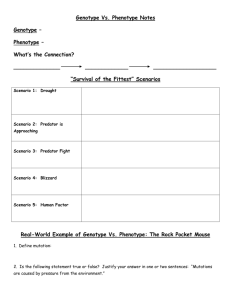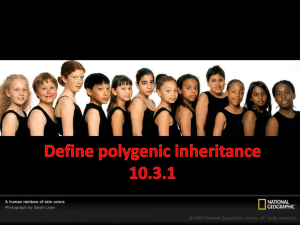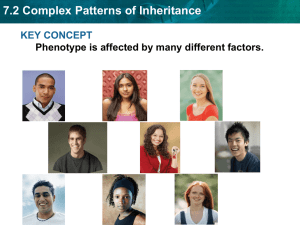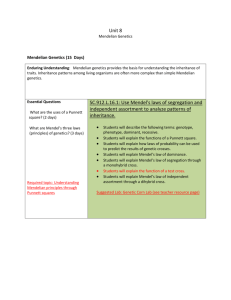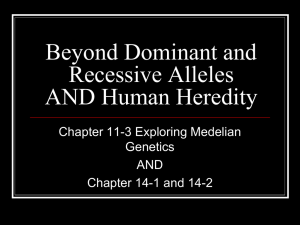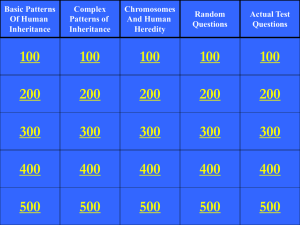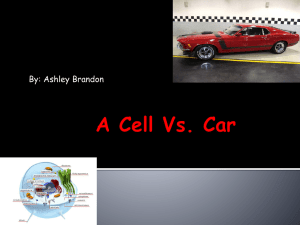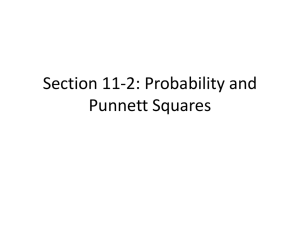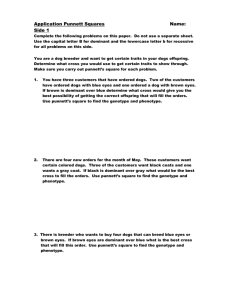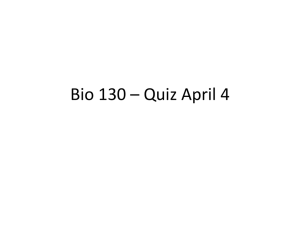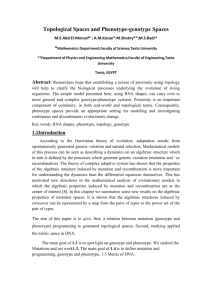Genetics
advertisement
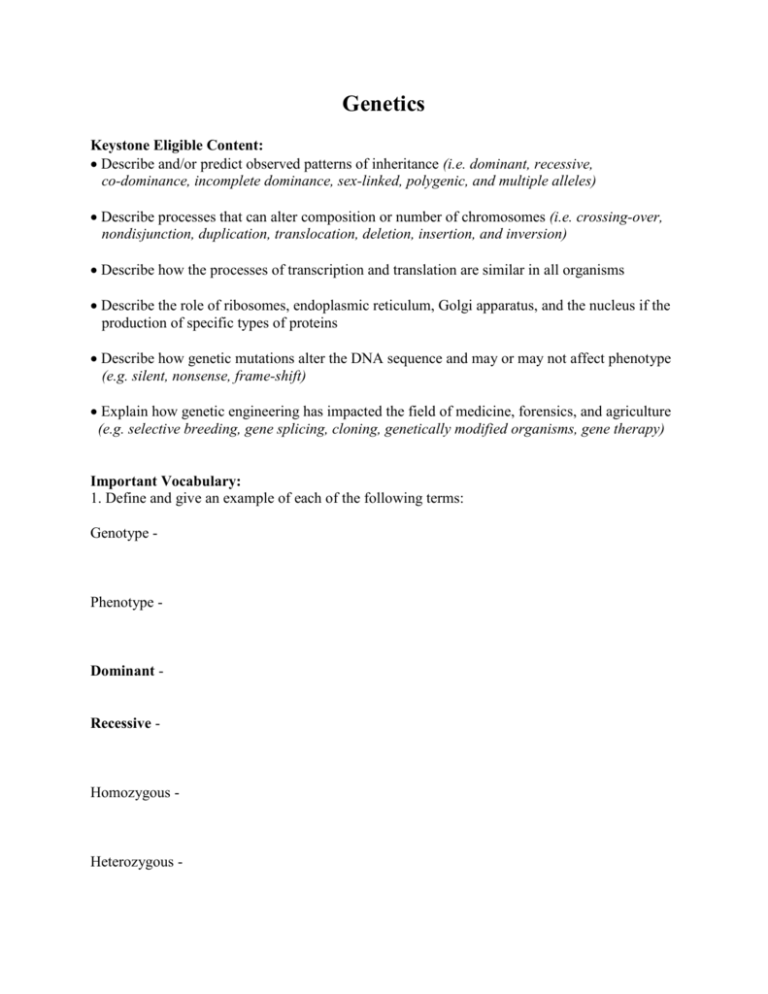
Genetics Keystone Eligible Content: Describe and/or predict observed patterns of inheritance (i.e. dominant, recessive, co-dominance, incomplete dominance, sex-linked, polygenic, and multiple alleles) Describe processes that can alter composition or number of chromosomes (i.e. crossing-over, nondisjunction, duplication, translocation, deletion, insertion, and inversion) Describe how the processes of transcription and translation are similar in all organisms Describe the role of ribosomes, endoplasmic reticulum, Golgi apparatus, and the nucleus if the production of specific types of proteins Describe how genetic mutations alter the DNA sequence and may or may not affect phenotype (e.g. silent, nonsense, frame-shift) Explain how genetic engineering has impacted the field of medicine, forensics, and agriculture (e.g. selective breeding, gene splicing, cloning, genetically modified organisms, gene therapy) Important Vocabulary: 1. Define and give an example of each of the following terms: Genotype - Phenotype - Dominant - Recessive - Homozygous - Heterozygous - Describe and/or predict observed patterns of inheritance (i.e. dominant, recessive, codominance, incomplete dominance, sex-linked, polygenic, and multiple alleles). 2. Define and give an example of each of the following patterns of inheritance: Codominance – Incomplete Dominance – Multiple Alleles – Polygenic Traits – 3. Japanese four o’clock flowers come in three varieties: red, pink, and white. Cross two pink Japanese four o’clock flowers. Show a Punnett Square and give the phenotypic ratio of the offspring produced by the cross. What pattern of inheritance is illustrated by this cross? 4. One parent is heterozygous for type A blood and the other is heterozygous for type B blood. What are the possible blood types of their children? Include the parents’ genotypes in your answer. 5. A female carrier does not have the disease. Her genotype is XHXh, where X indicates the alleles are on the X chromosome. The carrier female mates with a normal male. a) What is the probability that a female offspring will be normal? Will be a carrier? b) What is the probability that a male offspring will inherit hemophilia? 6. Cattle can be red (RR = all red hairs), white (WW = all white hairs), or roan (RW = red & white hairs together). Predict the phenotypic ratios of offspring when a homozygous white cow is crossed with a roan bull. What pattern of inheritance is illustrated by this cross? 7. Jumping Wickersnitches can have a variable number of eyes ranging from 2-8. You discover that there are three genes (6 alleles) responsible for this trait and begin breeding your Wickersnitches to demonstrate this polygenic inheritance pattern. Which of the following genotypes are going to have the same number of eyes? Assuming that 2 eyes is the most recessive and 8 eyes is the most dominant put them in order from fewest to most eyes. a. eeFFGG d. eeffGG b. EEFfgg e. EeFFgg c. EEffGg f. EeFfGG Use the pedigrees below to answer the next six questions. Pedigree A Pedigree B 8. What is the pattern of inheritance for the trait in pedigree A? (autosomal dominant or autosomal recessive) 9. What is the pattern of inheritance for the trait in pedigree B? (autosomal dominant or autosomal recessive) 10. What must be the genotype of individual 20 in pedigree A? 11. What must be the genotype of individual 17 in pedigree B? 12. What must be the genotype of individual 1 in pedigree A? 13. What must be the genotype of individual 1 in pedigree B? Describe processes that can alter composition or number of chromosomes (i.e. crossing over, nondisjunction, duplication, translocation, deletion, insertion, and inversion). 14. What is crossing over, and when does it occur during meiosis? 15. Distinguish between a chromosomal mutation and a gene mutation and give two examples of each type of mutation. 16. Define the term nondisjunction. Identify two chromosomal disorders which are a result of nondisjunction. Describe how the processes of transcription and translation are similar in all organisms. 17. Transcribe the given DNA sequence into a complementary mRNA: ATGCAAGTCATTCCAGCT __________________________________ Describe the role of ribosomes, endoplasmic reticulum, Golgi apparatus, and the nucleus in the production of different types of proteins. 18. Identify the function of each of the following organelles: Ribosomes – Endoplasmic Reticulum – Golgi Appapratus – Nucleus – Describe how genetic mutations alter the DNA sequence and may or may not affect phenotype (e.g. silent, nonsense, frame-shift) 19. How are frameshift and substitution mutations similar? How are they different? 20. Distinguish between a silent and a nonsense mutation. Use the tables below to answer the next two questions. Amino acid sequence Methionine-isoleucine-proline-leucine Methionine-isoleucine-valine-leucine Methionine-isoleucine-proline-alanine codon AUG CUA CCG AUA CCC Protein Produced Protein A Protein B Protein C Amino acid methionine leucine proline isoleucine proline 21. Follow the given sequence of DNA below through transcription and translation resulting in a protein. Fill in the missing information indicated by the question marks. TACTATGGCGAT AUGA ? ACC ? CU ? ?= ___ DNA methionine-isoleucine – ?-- ? ?= ___ ?= ___ ?= _________ ?= ___________ mRNA amino acid sequence Protein produced above (A, B, or C) (circle one) 22. If the above sequence of DNA had a substitution mutation so that the mutated sequence was TACTATGGGGAT, which protein (A, B, or C) will be produced? Explain how genetic engineering has impacted the field of medicine, forensics, and agriculture (e.g. selective breeding, gene splicing, cloning, genetically modified organisms, gene therapy) Assessment Anchor – Genetics: Describe and/or predict observed patterns of inheritance (i.e. dominant, recessive, co-dominance, incomplete dominance, sex-linked, polygenic, and multiple alleles). 1. A scientist observes that a certain trait is determined by a single allele. An organism inherited one version of the trait from one parent and another version form the other parent. Both versions of the trait are expressed in the phenotype of the offspring. Which pattern of inheritance best classifies the observed trait? a. dominance c. co-dominance b. sex-linkage d. incomplete dominance Use the table below to answer question 2. Phenotype A B AB O Blood Types Genotype(s) IAIA or IAi IBIB or IBi IAIB ii 2. Blood type is inherited through multiple alleles, including IA, IB, and i. A child has type A blood. If the father has type AB blood, what are all the possible phenotypes of the mother? a. phenotypes O and A c. phenotypes A, B, AB b. phenotypes A or AB d. phenotypes O, A, B, AB 3. A cattle farmer genetically crosses a cow (female) with a white coat with a bull (male) with a red coat. The resulting calf (offspring) is roan, which means there are red and white hairs intermixed in the coat of the calf. The genes for coat color in cattle are co-dominant. A. Although a farm has cattle in all three colors, the farmer prefers roan cattle over white or red cattle. Use the Punnett square to show a cross that would produce only roan offspring. B. Explain how a roan calf results from one white- and one red-coated parent. In your explanation, use the letters to represent genes. Be sure to indicate what colors the letters represent. ______________________________________________________________________________ ______________________________________________________________________________ ______________________________________________________________________________ ______________________________________________________________________________ ______________________________________________________________________________ ______________________________________________________________________________ C. Predict the possible genotypes and phenotypes of the offspring produced from two roan cattle. ______________________________________________________________________________ ______________________________________________________________________________ ______________________________________________________________________________ ______________________________________________________________________________ ______________________________________________________________________________ ______________________________________________________________________________ Describe processes that can alter composition or number of chromosomes (i.e. crossing-over, nondisjunction, duplication, translocation, deletion, insertion, and inversion). Use the diagram below to answer question 4. 4. Which type of change in chromosome composition is illustrated in the diagram? a. deletion b. insertion c. inversion d. translocation Describe how the processes of transcription and translation are similar in all organisms. 5. Which statement describes a cell process that is common to both eukaryotic and prokaryotic cells? a. Both cell types carry out transcription in the nucleus. b. Both cell types use ribosomes to carry out translation. c. Both cell types assemble amino acids to carry out transcription. d. Both cell types carry out translation in the endoplasmic reticulum. 6. The bacterium Acetobacter aceti is found in acidic environments and has an acidic cytoplasm. For this reason, most of its proteins are able to function in acidic conditions. This property distinguishes Acetobacter aceti proteins from those of most other organisms. Which characteristic does Acetobacter aceti most likely share with other organisms? a. the method that the organism uses to reproduce itself b. the physical and chemical responses to environmental changes c. the type of organelle used to produce energy for cellular functions d. the process used to form proteins by transcription and translation Describe the role of ribosomes, endoplasmic reticulum, Golgi apparatus, and the nucleus if the production of specific types of proteins. 7. The endoplasmic reticulum is a network of membranes within the cell, and it is often classified as rough or smooth, depending on whether there are ribosomes on its surface. Which statement best describes the role of rough endoplasmic reticulum in the cell? a. It stores all protein for later use. b. It provides an attachment site for larger organelles. c. It aids in the production of membrane and secretory proteins. d. It stores amino acids required for the production of all proteins. Describe how genetic mutations alter the DNA sequence and may or may not affect phenotype (e.g. silent, nonsense, frame-shift). 8. A genetic mutation resulted in a change in the sequence of amino acids of a protein, but the function of the protein was not changed. Which statement best describes the genetic mutation? a. It was a silent mutation that caused a change in the DNA of the organism b. It was a silent mutation that caused a change in the phenotype of the organism c. It was a nonsense mutation that causes a change in the DNA of the organism d. It was a nonsense mutation that caused a change in the phenotype of an organism 9. A mutation occurs at the midpoint of a gene, altering all amino acids encoded after the point of the mutation. Which mutation could have produced this change? a. deletion of two nucleotides c. insertion of six nucleotides b. deletion of three nucleotides d. insertion of twelve nucleotides Explain how genetic engineering has impacted the field of medicine, forensics, and agriculture (e.g. selective breeding, gene splicing, cloning, genetically modified organisms, gene therapy). 10. Genetic engineering has led to genetically modified plants that resist insect pests and bacterial and fungal infections. Which outcome would most likely be a reason why some scientists recommend caution in planting genetically modified plants? a. unplanned ecosystem interactions c. improved agricultural yield and profit b. reduced pesticide and herbicide use d. increased genetic variation and diversity
